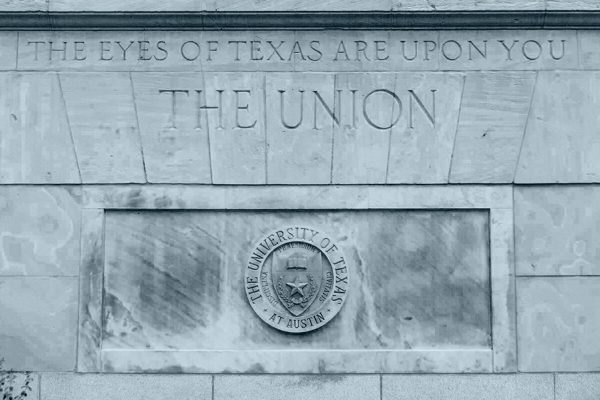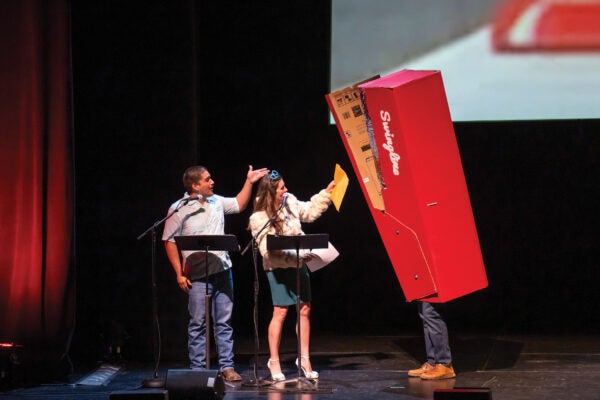When controversy over UT’s school song boiled over last summer as part of a national movement to root out institutional racism, President Jay Hartzell responded by meeting with dozens of groups and individuals about the matter. After weeks of listening, he decided that “The Eyes of Texas” should remain, but he also formed the Eyes of Texas History Committee.
The committee was something of a “truth and reconciliation commission.” With academic rigor befitting a university, it would establish the truth about the song, its origins, intended meaning, perceived meaning and ways it had been used over the almost 120 years since its debut. Then the group would turn to the business of reconciliation. How could we use the song as a springboard for talking honestly and openly about our past, present and future vis-a-vis race in particular? “Facing up to questions and challenges posed by the past can be deeply meaningful and invigorating,” says Hartzell. “It can also be frustrating and divisive. I want our university to be a model for society, a model for how we have hard conversations and take meaningful action, even as we disagree.”
Starting with the search for the truth, the committee confirmed that the song had been debuted at a minstrel show, and by students most probably wearing blackface. But, as committee member and renowned historian H.W. Brands put it, this was “happenstance”; the song was not created for minstrelsy and was not written in the mocking dialect of songs that were.
Another chief complaint about the song — its alleged Robert E. Lee connection — did not hold up to scrutiny. The committee could find no primary-source evidence that the song’s signature line was inspired by a similar saying of Lee’s, and it could not even find evidence that Lee himself had said what supposedly inspired it: “The eyes of the South are upon you.” As for the tune, borrowed from “The Levee Song,” or “I’ve Been Working on the Railroad,” the committee concluded that it likely was chosen because it was familiar to students, not as a nod to that song’s clearly racist, dialect-laden lyrics.
But a “not guilty” verdict is not the same as innocent, and this nuance seems to be the crux of the committee’s work.
“There’s nothing whatsoever to indicate that it was intended at all in the direction of Black people,” says Brands. “They just weren’t part of the audience. They weren’t part of the people (lyricist John Lang Sinclair) was thinking about because there were no Black students then.”
And here Brands puts his finger on the issue: “The University of Texas was a Jim Crow university in a Jim Crow state. Anything that emerged from that background could be said to have ‘racist origins.’”
The song was undeniably “racist-adjacent” with its minstrel show debut. But on a campus whose first Black student wasn’t admitted until 1950 and then only by the force of the federal government, whose off-campus faculty club was not desegregated until President Lyndon Johnson himself showed up with a Black guest in 1963, and whose football team infamously remained all white until 1969, purging all racist-adjacent traditions would leave few traditions, if any. The larger point, though, is that to know the song’s history is to better understand the evolution of the university, of the state and of the nation itself.
Committee member Cloteal Davis Haynes is Black, came to UT as a student in 1968 and felt little connection to the university. “If the facts had revealed that the song was racist, I have to say, it would not have surprised me,” she says. “The surprise for me was that it wasn’t.”
This is the creative tension that the work of the committee uncovered and is the spark that UT leaders hope can light the way to a more forthright and unified future for the Longhorn Nation. As committee Chair Rich Reddick, an associate dean, puts it: “If (UT) had made the decision to get rid of ‘The Eyes of Texas,’ or to keep ‘The Eyes of Texas’ and just kind of keep moving on, we would have lost the opportunity to dig deeply into a past that — it’s painful at certain points. There are parts that are really hard to stomach, but then there are parts when you say, ‘I had no idea that took place!’ That opportunity to me is the high point of this work. It’s a chance for us to use ‘The Eyes of Texas’ to look into how this university has evolved.”
When the committee turned its attention to the next step — reconciliation, as it were — its recommendations were high level and broad ranging. Many of them were geared toward ensuring the song’s history was visible and that future generations would not feel blind-sided by its origin story. Many involve fostering uncomfortable conversations.
These conversations will fall heavily within the bailiwick of LaToya Smith, UT’s new vice president for diversity and community engagement. “This song forces us to talk about inclusion and decide who we are going to be moving forward,” Smith says. “We could stick our head in the sand and not reflect on the past, but our students forced us to be uncomfortable and have difficult conversations. There is no progress without pains of discomfort.”
“The history and the lyrics as Dr. Reddick so eloquently described have been part of our story as Texas, and it has evolved,” she says. “But our story isn’t finished yet. We’re still writing. I take personal responsibility for holding this university accountable so that our story is not about segregation anymore — it’s about inclusion and equity and access.”
“The United States is a work in progress,” says Brands. “The state of Texas is a work in progress. The University of Texas is a work in progress. And in that context, I would say that the song ‘The Eyes of Texas’ is a work in progress as well.”




